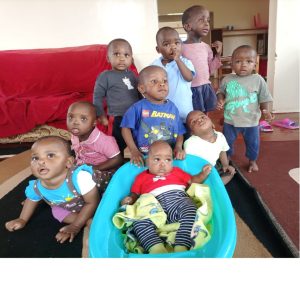Our last blog explained how abandoned babies are a major issue in Kenya. To help improve their life prospects Kenya Children Centres funded the creation, and continues to fund the day-to-day operations, of a dedicated Abandoned Baby Unit in the Kujali Children’s Centre, a Charitable Children’s Institute (CCI) near Thika.
Governed through the local Children’s Office against the requirements of the Children Act 2022 and operating in alignment with the National Standards for Charitable Children’s Institutions, Kujali works closely with the local Children’s Office to address the issues of abandoned babies and to give the babies the best possible chance of a future.
 The Kujali compound sits on an acre of land in Ngoingwa, near Thika, which was donated by a local women’s cooperative. The purpose-built Abandoned Baby Unit occupies the top floor of the main building, providing a loving, safe and secure environment, alongside some of the other Child Welfare Programmes run by Kujali – short-term residential care for children placed by the Courts and our centre for Teenage Mothers.
The Kujali compound sits on an acre of land in Ngoingwa, near Thika, which was donated by a local women’s cooperative. The purpose-built Abandoned Baby Unit occupies the top floor of the main building, providing a loving, safe and secure environment, alongside some of the other Child Welfare Programmes run by Kujali – short-term residential care for children placed by the Courts and our centre for Teenage Mothers.
Since it was opened in 2019 the Abandoned Baby Unit has taken in 36 babies. 14 have been reunited with their families, 11 have been adopted and one fostered. One sadly died.
We asked Rachel, the manager at Kujali, to explain how a baby is placed at Kujali. These are her words:
“The Abandoned Baby Unit looks after babies from 0 months up to two years of age. It also looks after neglected or street babies who may be placed in the Unit for temporary care and protection.
Admission into the Unit is a clearly defined process. If the baby is abandoned on the streets, whoever saves the baby must report it to the police, who record it in their Occurrence Book (OB) and issue an OB number. This is for security because child trafficking is on the rise. The baby is immediately taken to a hospital and admitted to their Baby Unit for observation and treatment until they are stable, pending placement at Kujali through the Children’s Office and the Court.
If abandoned in the hospital, the hospital Social Worker reports to the police who issue a Police letter. Once the child’s life is out of danger, the hospital Social Worker notifies the Children’s Officer and requests them to identify a home where the child can go to receive love, care, and protection.

A Committal Order from a Magistrate must accompany the placement. This protects Kujali in case a mother reports to the Police that her baby has been stolen.
The Kujali Nurse and Caregivers receive the baby in the unit in a loving manner, change the baby’s bedding and clothes, and introduce them to the other babies in the unit.
The Nurse checks the general condition of the baby and, in case of any deformity, abnormality or major illness refers them back to the health facility for a check-up. The Kujali Social Worker notifies the Children’s Officer about the issue.
If the baby is between 0 and six months we begin to feed them Cow & Gate Formula No.1. If the baby is six months or older immediate weaning begins in addition to Cow & Gate Formula No. 2.
As soon as the child is in our care one of our Social Workers tries to trace the baby’s family using any information provided by the hospital (discharge summary), Police letters and the Subcounty Children’s Officer placement letter.
The key reason for tracing is to see whether, even in the mother’s absence, there might be a next of kin willing to care for the baby since it is better for the child if they can grow up in a family and not an institution.
If our Social Worker cannot trace the mother or family, they notify the Children’s Officer to get permission for the baby to be put up for adoption and allow us to prepare the necessary documentation, being:
- The hospital discharge summary
- Medical history
- 1st Police letter
- Placement and Committal order
- Tracing report
- 2nd Police letter
Kujali engages a local adoption agency (Buckner), which then begins the process of adoption or fostering. Buckner identifies prospective parents who are ready to adopt a baby or babies and manages the process. This involves the matching of photos for resemblance purposes, then bonding takes place within Kujali under the supervision of the Nurse and the Caregivers for 3 consecutive days before the final adoption day. Because many of the babies that we care for have disabilities, one of the reasons for their abandonment in the first place, adoption can be very difficult, if not impossible. In these cases, we look for foster parents or more suitable homes that can give them the specialised care that they need as they grow.
Once the baby has been adopted or fostered, the agency continues to guide the new parents through the legal court process until they finally receive the appropriate certificate issued through the court.”
Our next blog will explain “a day in the life” of the unit.


This Post Has 2 Comments
Kujali attributes all the success of this work to God, our passionate and generous donors and all well wishers. Thank you.
Nice one, will visit you when I can to learn more about how to adopt a child. Good work God bless you